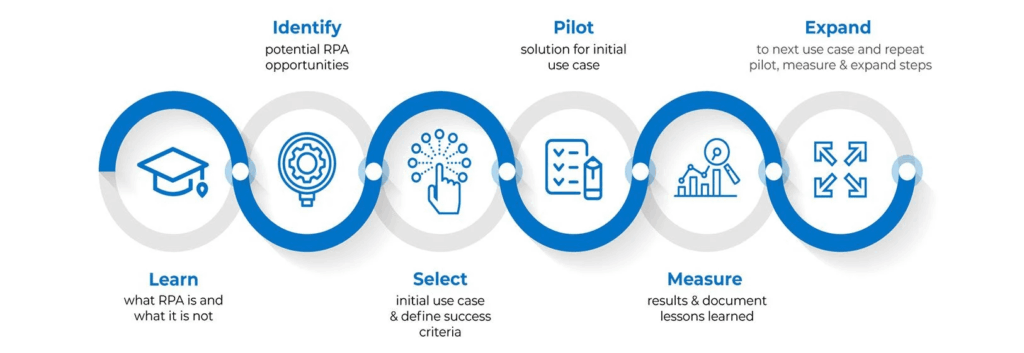Introduction
Robotic Process Automation (RPA) is a technology that has emerged with the need to streamline processes across the organization. RPA is thereby not specific to development, testing or QA, but relevant to essentially any department.
Benefits of RPA Automation Testing
- Save time. Monotonous regulatory undertakings are a typical piece of numerous business processes
- Increment return for money invested
- Kill human mistake
- Hoist security
- Increment consistence
- Scale business process mechanization
- Worker fulfillment

Key Features of RPA Tools in Testing
- Rich-Logical Suite
- Security
- Basic Bot Creation Connection point
- Source Control
- Facilitating and Sending Choice
- Rules-based Exemption Taking care of
- Investigating
- Less Content or Content Less Computerization
Is software tester a difficult job?
Implementing RPA Automation Testing in Different Industries
Reception of RPA is developing quickly across enterprises, including banking and money, medical services, assembling, protection, and life sciences. A portion of the cross-business use instances of RPA incorporate receipt handling, finance the executives, bookkeeping compromise, and representative on-boarding.

Challenges and Solutions in RPA Testing
- Complex Undertakings.
- Absence of IT Arrangement.
- Profit from Venture.
- Adaptability and Development.
- Recognizing the Cycles Requiring Robotization.
- Apparatus Exploration and Determination.
- Testing and Emphasizing.
- Upkeep and Observing.
How to Choose the Right RPA Testing Tool
- Simplicity of Execution. One of the most incredible elements of RPA innovation is its simplicity of execution, painlessness, and similarity with existing inheritance frameworks
- Convenience
- Speed
- Specialized Highlights
- Possession Cost
- Versatility
- Engineering
- Exemption taking care of

Compatibility Testing in Software Testing
Step-by-Step Guide to Setting Up RPA Tests
Track down cycles to robotize.
Get association wide purchase in.
Pick the right robotization programming.
Foster an execution plan.
Test your answer.
Rollout and change.

Real-life Applications of RPA Testing
Site Scratching
Call Center Tasks
Consistence Revealing
Client Request Handling
Representative Onboarding
Mastercard Applications
Booking Frameworks
Claims Organization
Future Trends in RPA Automation Testing
- Mental Robotization includes the utilization of man-made intelligence and ML to engage RPA bots with mental abilities, for example, regular language understanding and example acknowledgment. This permits bots to deal with additional perplexing errands that were recently held for human workers.

Addressing Security Concerns in RPA Testing
RPA Security system
Abstain from utilizing hard-coded admittance freedoms
Utilize the ‘least honor’ guideline
Log’s trustworthiness ought to be kept up with
Safely empower RPA improvement
Classified data divulgence
Impediments in the framework
Forestall security issues that can prompt extortion and abuse

The Role of RPA in Continuous Testing
RPA arrangements might expand the efficiency and effectiveness of Testing and QA Administrations by 80% and assist with putting up additional highlights for sale to the public all the more rapidly. The product can rapidly develop and convey bots with the least specialized skill conceivable by utilizing RPA arrangements.

Conclusion
In concluding our exploration of RPA automation testing, it’s evident that this technology is not just a tool; it’s a revolution. It reshapes the landscape of software testing, offering unparalleled efficiency, accuracy, and adaptability. Organizations are encouraged to embrace the benefits of RPA to elevate their testing strategies and ensure software quality in the fast-paced digital era.
FAQs
- Is RPA testing suitable for all types of software applications?
- Yes, RPA testing can be adapted to test a wide range of software applications, from web-based to desktop applications.
- How does RPA contribute to cost savings in software testing?
- RPA reduces the need for manual intervention, saving time and resources, which translates into cost savings over the long term.
- Can RPA testing be integrated into an existing testing framework?
- Absolutely, RPA is designed to complement existing testing methods, creating a harmonious and comprehensive testing approach.
- What security measures should be in place when implementing RPA testing?
- Implementing secure coding practices, encrypting sensitive data, and regularly updating security protocols are crucial when using RPA in testing.
- Are there training resources available for teams new to RPA testing?
- Yes, many RPA tool providers offer comprehensive training resources to help teams adapt to and maximize the benefits of RPA testing.
You may be interested in:
Top Skills Required to Excel as a SAP MM Consultant
Alpha Testing and Beta Testing: Layers of Software Evaluation

